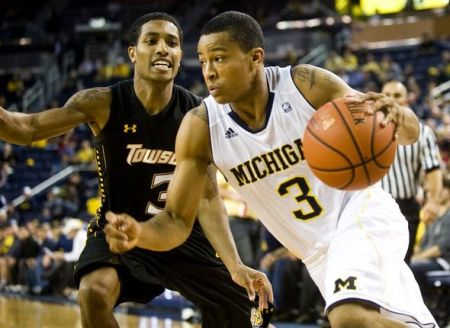Key Observations From Michigan’s Tough Four-Game Stretch
Posted by Deepak Jayanti on February 13th, 2013Deepak is a writer for the Big Ten microsite of Rush The Court. Follow him on Twitter for more about B1G hoops at @dee_b1g.
Playing four games over the course of 11 days is not an easy task for any basketball team, especially true if the games are in the toughest conference in the nation. What the Michigan Wolverines had to go through since February 2 can’t be compared to any normal four-game stretch because they faced three of the top Big Ten teams — Indiana, Wisconsin, and Michigan State — in front of thousands of raucous fans which can be very exhausting. As if those road games were not enough, they arguably played in the most competitive game of the league season against Ohio State in Ann Arbor. Two weeks ago, we knew that John Beilein’s squad would be tested during these games but the match-ups turned out to be much tougher for the Wolverines than anticipated. Three road games which included two overtimes have given us a very good sample to understand the strengths and weaknesses John Beilein’s team and the following are three key observations since Michigan’s game two Saturdays ago against the Hoosiers.
- Good defensive teams will let Trey Burke beat them, but only from the perimeter. Burke is shooting 38% from beyond the arc which is a decent long-range shooting percentage but the three-ball is not his forte. Rather, he is most dangerous once he gets by his defender into the paint and has three options: pull up for a jumper from the high post, kick it out to Nik Stauskas or Glenn Robinson in the corner, or drive all the way to the basket to draw the foul. Except for a few pick-and-roll plays with Mitch McGary, Burke hasn’t had much success consistently driving to the basket over last few games and all of the credit goes to good scouting and defense by Victor Oladipo, Aaron Craft, Ben Brust and Keith Appling. He scored 19.5 PPG during the four games but also attempted an average of eight shots from beyond the arc, which indicates a tendency to settle for poor shot selection to some extent. If he can consistently hit the step-back three, opposing teams will gladly let him beat them that way because it is not as high a percentage shot for a player with Burke’s gifts. By keeping Burke on the perimeter, the Wolverines’ threat from the corners are also neutralized, which hurts the offensive games of Robinson and Stauskas. Read the rest of this entry »










































